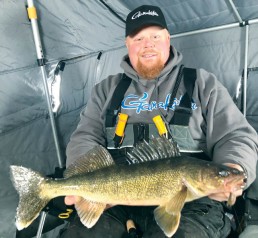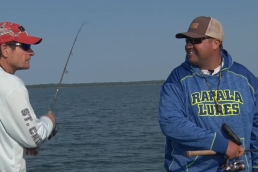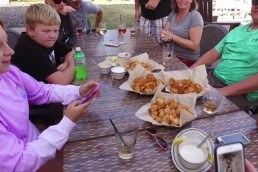Feast or Fasting Walleyes
SHARE THIS POST
Early ice can be some of the best walleye fishing of the ice season. Walleyes are still bingeing in their bulk-up mode that began during the late-fall cool down. However, the accessibility on early-ice limits anglers from exploring large lakes due to varying ice thickness, ice heaves and the amount of work it takes to drill or chisel, measure and walk forward. By the time angler mobility improves, walleye feeding patterns are changing, which means adjusting your approach.
Getting farther, faster
As the temperatures remain consistently cold and we move beyond “early ice,” most waters have solid, thicker ice. Trails in the snow left byexperienced ice anglers visible. Large lakes like Lake of the Woods, Upper Red Lake, Mille Lacs and Leech Lake have trails flagged and marked by resorts and guides. Resorts are also pulling their rental houses out to spots that they use every year. This is the start of ATV, snowmobile and light truck travel—and one of my favorite times to fish!
I use a machine or my Chevy Tracker to get out to more remote spots. Horsepower is better than foot power, making large waters seem smaller. As I explore, I also rely on LakeMaster maps on my Humminbird Helix 8 to locate potential structures to fish.
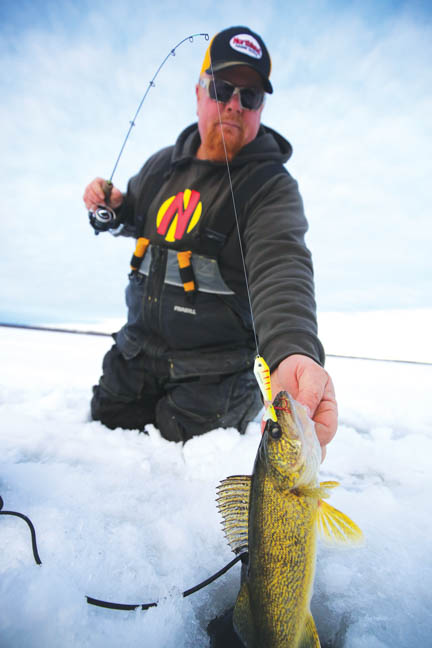
What to look for
This time of year, walleye feeding becomes more of a binge and fast cycle. Walleyes still need to eat to keep their core functions fueled, but their metabolism is slower. Large baitfish schools will always have walleyes nearby, so anglers should take notice if they are seeing bait on their sonars. Structures that have lots of minnows will be lined with walleyes from the top and down the break, with others nearby, resting in the basin or even suspended over the basin at the level of the hump top or drop-off. For example, if you have a bar that tops out at 15 feet surrounded by 50 feet of water, the walleyes can hold 15 feet down over deep water within several hundred feet of the structure. I refer to them as “airplanes” circling the runway, waiting to land.
Triggering a feeding response is still fairly easy with the right bait and jigging cadence. I have seen walleyes on my Aqua-Vu Micro 5 Revolution strike aggressively, while others swim up, bump and pass on my offering. The Micro 5 is a great learning tool. And the Aqua-Vu HD 7i underwater camera is amazing, even in slightly turbid water.
Presentation matters
The Northland Fishing Tackle Buck-Shot Coffin Spoon is my first approach to jigging up walleyes. When picking colors, the lake dictates the patterns and colors you will use. Lake of the Woods has tons of rusty crayfish; they are a major food source for this body of water, so red or pink colors are always great spoon colors. In stained water, gold seems to pierce through the murk, imitating young-of-the-year perch, tullibees and emerald shiners. Grab lots of Northland Fishing Tackle Coffin Spoons in multiple colors
on your way to the lake.
Fasting walleyes
As winter progresses, walleyes tend to forage on insect larvae that are amply distributed all over the basin. Many times, panfish-style baits out-fish larger, aggressive walleye tackle. When you catch a quick walleye ripping a spoon, and the rest swim by without a second glance, you know that it is time to throw something larva-shaped at the fussy tire kickers.
Northland Fishing Tackle’s Bro Bug Spoon has the slender shape and beady eyes of a Mayfly larva, and the long shape of a bloodworm. When we first used the protype of the Bro Bug Spoon, we were on Upper Red Lake doing a photo shoot with a limited handful; the Bro Bug Spoon out-fished everything else that we threw. Simple lure changes of color and shape win tournaments and fill buckets.
Are you enjoying this post?
You can be among the first to get the latest info on where to go, what to use and how to use it!
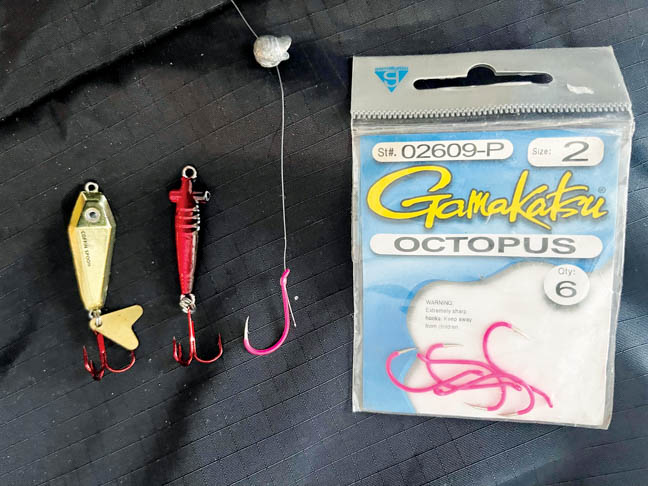
I run Sunline Fluorocarbon Ice 5- to 7-pound-test on my two jigging rods. I always start out with a ¼-ounce gold Coffin Spoon with a minnow head, snipped by the dorsal fin, no matter what lake I fish. In my Plano Edge Series 3500 tackle box, I also have Red Glo, Pink Tiger, Green Tiger and Sneeze colors waiting to get in the game.
Drop the Coffin Spoon down to 4 feet off the bottom and give it a 2-foot sweep. The spoon will tumble back down, rattling and flashing all the way. Give it a 3- to 5-second pause and repeat. If fish come into view and stay near, continue the jigging cadence. If they flare away, try a shorter shake on the rod tip to create rattle and flash, but in a less aggressive cadence. If you get a few drive-by swimmers, switch to a second rod with a 1/8-ounce Bro Bug Spoon; Red Glo or Purple Wonder Bread would be my first color choices. A tighter-snipped minnow head might be in order. Even fasting walleyes will take a snack if not a full meal.
A deadstick is the third of three rods that I take along when I am doing my walk-about on the ice. A deadstick rod has a super soft tip, and I secure it on a small, portable rod holder. On this rod, I run 3- to 4-pound Sunline Fluoro Ice and use a #2 Gamakatsu Neon Pink or Red Octopus style hook with a fathead minnow. Rainbows or small suckers are also great options. Hook them through the back behind their dorsal fin and add 1 or 2 split shot weights to sink them into place. For overactive minnows, snip the top of their tail off with your thumb nail.
Drop these live bait presentations down to 1 to 4 feet above the bottom. No bobbers are needed; the soft rod tip is a great strike indicator. When the tip bends, pause for a 3- to 5-second count. Then sweep the rod up into a hookset. If the fish steals your bait or bites your minnow in half, increase the amount of rod bend count to 10 to 20 seconds, or nose-hook the minnow.
Keep moving
When I am actively fishing on the ice, I use my RAZR Scout Auger to drill three holes in a triangle pattern, 6 to 9 feet apart from the top of the sandbar or structure I am fishing over, to the side and out to the basin. One hole is for the jig rod, one for the deadstick and one for my Humminbird 360. For example, on Upper Red Lake, I might be on a sandbar high spot in 11 feet that slowly dumps to 13 feet within 150 yards; this may take a couple dozen drilled holes. On Leech Lake, the top of a structure might break into the basin in 10 yards. I will put my Humminbird 360 in the top middle hole in front of me and watch for shadows and fish movement. If the fish are moving in a different direction, cut holes where you see them swimming through on the 360. Where structures are small, you can drill a field of holes and put the 360 in the middle, and then walk to the hole you see the fish swimming through consistently.
‘Bro Tip: When I’m covering ice drilling holes, I always wear my Fish Monkey Yeti Gloves— especially if the temperatures are below zero. As much as you may want or need to drill more holes to continue the search for fish, frozen hands will stop you!
As the ice gets thicker this time of year, so does traffic, including a growing number of wheelhouses. Camping on the ice can be a great time, but vehicles pulling heavy loads create a huge amount of cracking and popping noises from the ice. Plow trucks maintaining ice roads create the next level of noise terror for fish.
Try to fish off the beaten path and stay clear of the noise. The walleyes will be right there with you! Noise and angler pressure defrays the bite. That is why anglers are quick to park their wheelhouses in newly plowed areas on large lakes. New spots have a higher activity level, as fish move through and away from community noise.
At the core of all of this is the reminder to practice safety first. I have watched anglers pull tandem-axled houses behind large trucks on undrilled and unexplored ice, thinking driving fast will help. Wrong! Putting a vehicle and house through the ice is a catastrophic event. It’s not only a threat to your life and your passengers but requires tens of thousands of dollars in recovery fees! So, drill before you go and make sure you have more ice than you need. Drive your vehicles slowly; ice floats and is flexing under the weight of vehicle traffic. Excess speed creates pressure cracks between you and your exit from the lake. Observe DNR ice recommendations for ice safety.
Pack a portable Frabill flip-style or pop-up house—or go light with a bucket and rods. Wheelhouses are a great base camps, but being portable is the best way to stay on mid-winter walleyes.
Good luck ice fishing! I’ll see you on the ice!
MWO
SHARE THIS POST
You may also like...
Did you enjoy this post?
You can be among the first to get the latest info on where to go, what to use and how to use it!
Brian 'Bro' Brosdahl
Outdoor communicator Brian “Bro” Brosdahl lives in northern Minnesota. He is a walleye guide in the Cass Lake, Leech Lake and Lake Winnibigoshish areas. He is sponsored by Northland Fishing Tackle, Frabill/Plano, Aqua-Vu, Humminbird/Minn Kota, St. Croix Rods, Ranger Boats, and Evinrude. Guide inquiries: brosguideservice.com. Follow on social media.
